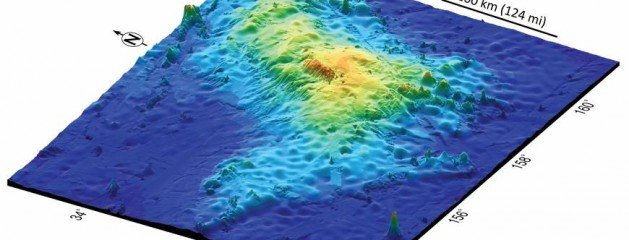The largest single volcano ever found on Earth lies quietly in the depths of the Pacific Ocean, about 1,500 km east of Japan, having been extinct for millions of years. Scientists have now discovered the dome-shaped behemoth, which has a footprint the size of New Mexico.
The discovery topples the previous world record holder for largest volcano — Mauna Loa, one of the five that form the Big Island of Hawaii. The area covered by the newly discovered volcano rivals the biggest volcano in the solar system, Olympus Mons on Mars.
“Olympus Mons is the 800-pound gorilla of the solar system,” said geophysicist William W. Sager of the University of Houston, the study’s lead author. “We didn’t know these massive volcanoes were here on Earth.”
The team named it Tamu Massif. TAMU is the abbreviation for Texas A&M University, Sager’s home institution when he and colleagues first studied the undersea mountain range that contains the giant.
Tamu Massif formed layer by layer as fast-moving lava flowed from a central area at the peak and ran down its flank, cooling in place. The volcano is completely submerged, and Sager does not believe that its peak ever rose above sea level over its 145-million-year lifetime.
There is no danger of an eruption. “That’s probably a good thing, since we’ve been able to correlate mass extinction with some of these beasts,” said Clive Neal, a volcanologist at the University of Notre Dame.
Neal, who was not involved in the study, said the discovery of such an oversize volcano on Earth is groundbreaking for volcanology.
“This finding is paving the way to really rewriting some of the textbooks,” he said. “The term ‘supervolcano’ might be a reality.”
Although Tamu Massif has a gigantic footprint, it is relatively short compared to Olympus Mons. The newly discovered volcano rises only a few kilometers above the sea floor, while the gargantuan Martian mountain rises 22 km at its peak.
Gigantic volcanoes can form more easily on Mars because, unlike the Earth, whose crust is made up of many separate plates constantly in flux, the red planet has a thick, rigid outer shell made of a single plate. If a volcano forms over a hot spot under the Martian crust, it can keep growing bigger and bigger because the plate stays stationary.
For an Olympus Mons-size volcano to form on Earth, magma must have flowed out extremely quickly in order to keep adding layers before the plates moved away from the hot spot.
The study was published online in the journal Nature Geoscience.
Sager and his colleagues first studied Tamu Massif on a research cruise almost 20 years ago without knowing it was a single volcano. At the time, they were gathering data on a larger undersea mountain range called Shatsky Rise, which contains the giant within its features.
Two decades, with a total of over a year actually at sea, passed by before they managed to gather enough evidence through core samples and seismic-reflection data to confirm that much of Shatsky Rise is made up of one central volcano.
“It’s nice to be able to find something that’s new and exciting and makes people look up from their cup of coffee,” said Sager.
Neal said the discovery proves how little we know of our own planet. He said he is eager for other large volcanoes to be uncovered. Both Sager and Neal suspect that the Ontong Java Plateau in the southwestern Pacific Ocean — which is the size of Alaska, even larger than Shatsky Rise — contains a massive volcano that could dethrone Tamu Massif.




